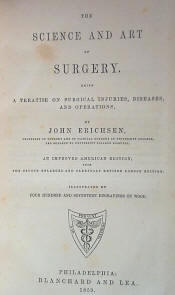John Erichsen, M.D.
View the surgery book by Dr. Erichsen in this collection
Name: John Eric Erichsen
Death date: Sep 23, 1896
Place of death: London, England
Type of practice: Allopath
Journal of the American Medical Association Citation: 27:825John Erichsen's Science and Art of Surgery of 1859, was the major medical text given to the surgical and medical staff during the Civil War. The book went thru 10 different editions and was translated into 15 different languages. Contains information on surgical procedures, gunshot wounds, amputations, and other treatments.
Sir John Eric Erichsen, 1st Baronet (19 July 1818 - 23 September 1896) was a British surgeon, born in Copenhagen. He studied medicine at University College, London, and at Paris, devoting himself in the early years of his career to physiology, and lecturing on general anatomy and physiology at University College hospital. His Science and Art of Surgery (1853) went through many editions. and was the most popular military surgery manual during the American Civil War. He rose to be president of the College of Surgeons in 1880. From 1879 to 1881 he was president of the Royal Medical and Chirurgical Society. As a surgeon his reputation was world-wide, and he counts (says Sir W. MacCormac in his volume on the Centenary of the Royal College of Surgeons) among the makers of modern surgery. He died at Folkestone in 1896
"The most popular text-book on the subject for many years. Erichsen was surgeon to University College Hospital, London, and Lister served as his house surgeon." "Editions from the 2nd London edition were published by Blanchard & Lea, of Philadelphia, in 1859, and again in 1860, and a copy was issued by the American Government to every medical officer in the Federal Army during the American Civil War" (Plarr's Lives of the Fellows of the Royal College of Surgeons of England, Vol. I, p. 380). Wyndham Miles writes, in his History of the National Library of Medicine (p. 18), that 5370 copies of Erichsen's book--presumably the 1860 edition--were purchased by the government for distribution during the Civil War.
"As a surgeon Sir John Erichsen's reputation was world-wide. His strong faculty was his sound judgment ripened by a vast experience which gave him an almost unrivalled clinical insight. There was no man in the profession whose opinion in a difficult case was more justly held to be of great weight. . . . He had, in his earlier days at least, no English superior as a clinical teacher. Lord Lister, Sir Henry Thompson, and Marcus Beck were amongst his house surgeons, and he may be looked upon as one of the makers of modern surgery. As a man he possessed a most attractive character. He was honorable and candid in all the relations of life, a generous friend, a gentleman in every sense of the word, of peculiar affability and courtliness of manner. Richard Quain had long refused to speak to him on the ground that he, although senior, had been passed over in favor of Erichsen, a junior, in the appointment to the Chair of Surgery at University College, but Sir John Erichsen's patience and conduct at length convinced Quain of the injustice of his attitude. To everyone's surprise the two men one day entered the hospital arm-in-arm. He was very successful in his profession and he owed much of this to a happy combination of good qualities. His work occupied a high place in surgical literature, and he was always ready to accept the surgical advances of younger men. He was a distinguished teacher in a school where many distinguished surgeons had preceded him. If he did not strike out any new path in the field of surgery, he possessed a sound judgment enlightened by a long experience, had much administrative talent, a wise eloquence, dignity of presence, and elevation of view" (Plarr's: Lives of the Fellows of the Royal College of Surgeons of England, Vol. I, pp. 379-80).
The first American edition was published in 1854. Garrison-Morton 5602 (citing 1st London ed., 1853): "The most popular text-book on the subject for many years. Erichsen was surgeon to University College Hospital, London, and Lister served as his house surgeon." "Editions from the 2nd London edition were published by Blanchard & Lea, of Philadelphia, in 1859, and again in 1860 [edition offered here], and a copy was issued by the American Government to every medical officer in the Federal Army during the American Civil War" (Plarr's Lives of the Fellows of the Royal College of Surgeons of England, Vol. I, p. 380). Wyndham Miles writes, in his History of the National Library of Medicine (p. 18), that 5370 copies of Erichsen's book--presumably the 1860 edition offered here—were purchased by the government for distribution during the Civil War. Only Freeman Bumstead's Pathology and Treatment of Venereal Diseases was purchased in a larger quantity!

